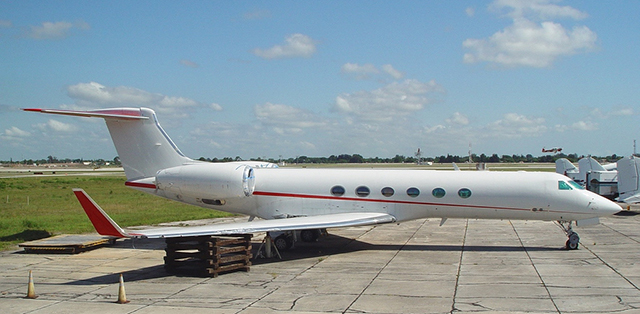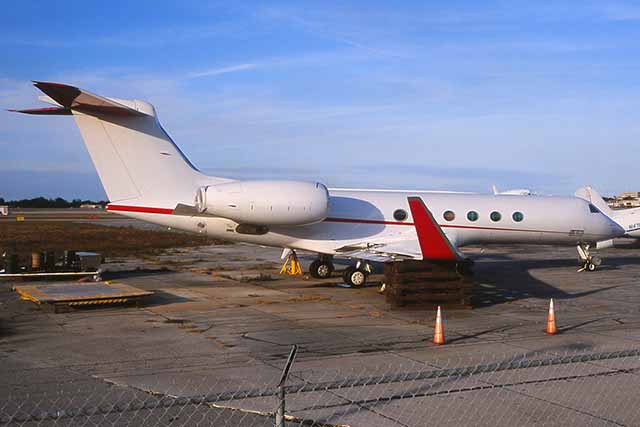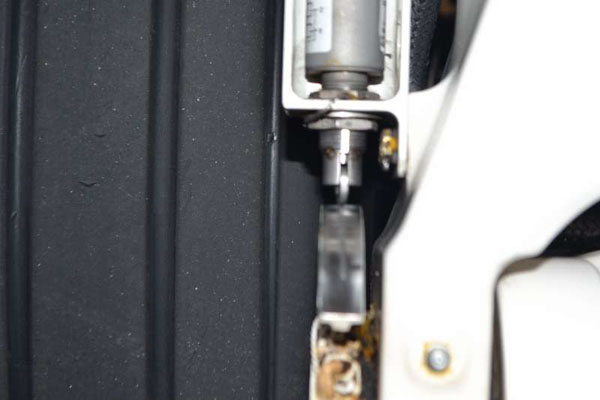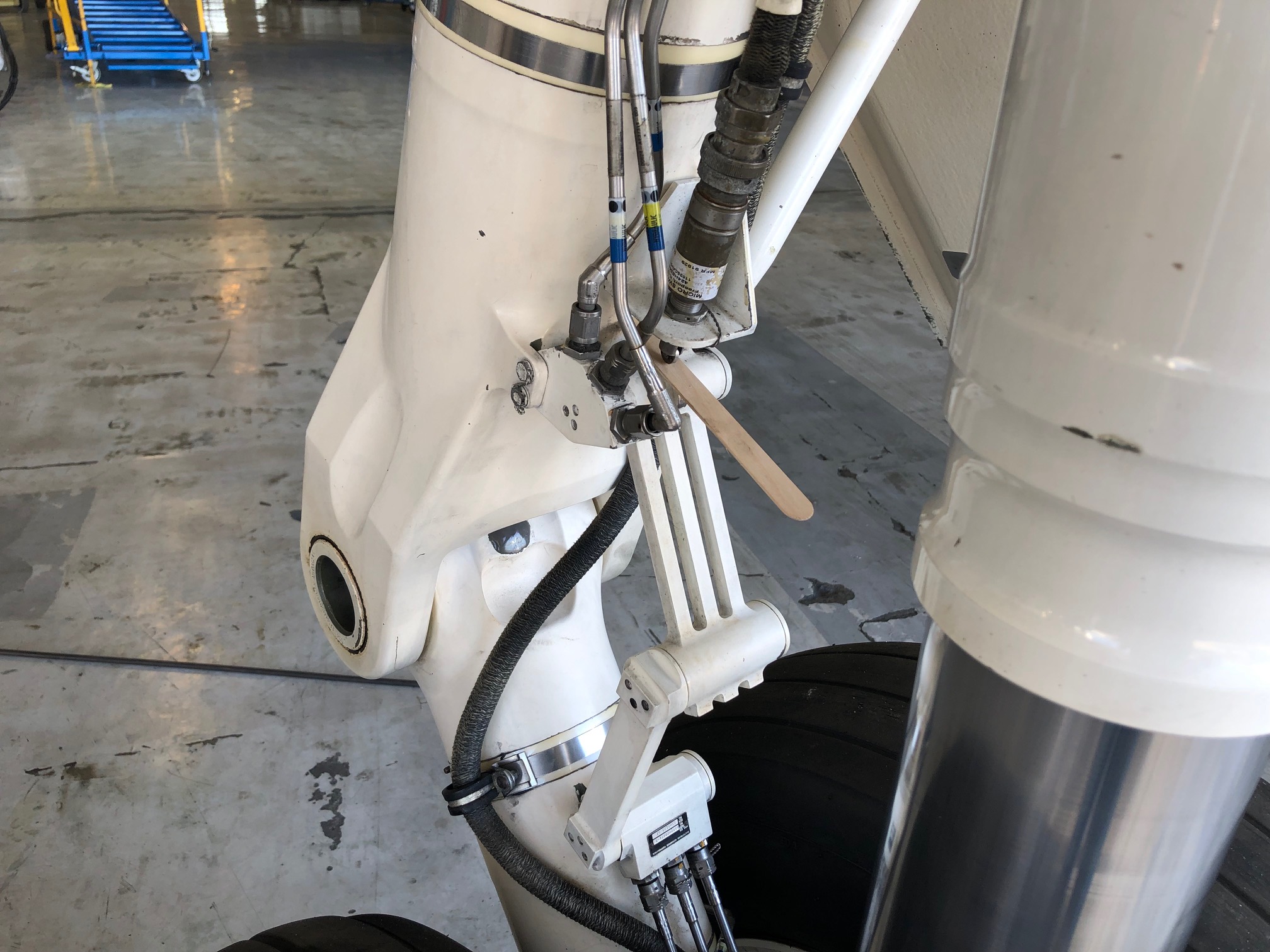According to the accident report this mishap was caused by by mechanics who forgot to remove Popsicle sticks used during routine maintenance and by Gulfstream who should have had a better method to disable the weight on wheel switches. Those points are true, but they didn't cause the mishap. The mishap was caused by pilots who failed to perform a complete external preflight, failed to correctly analyze clearly presented crew alerting system warnings, and failed to execute the proper emergency procedure checklists. Additionally, they failed to take advantage of several commonly accepted techniques, any one of which would have prevented this aircraft from being destroyed.
— James Albright

Updated:
2019-01-24

N777TY, view of right wing damage
Matt Birch (http://visualapproachimages.com/)
In the words of the captain, these pilots "blew it." I think they did. But I'm not sure they were bad pilots, they made it to the premier jet in corporate aviation. There weren't many GV pilots in 2002 and they had to be of a special cut to make it to that jet. But even the best pilots can become complacent and complacency shows at every phase of this mishap. I think there are several lessons here for all pilots, Gulfstream or not:
- We often rush the external preflight because we almost never find anything wrong with the airplane. As we become more and more complacent we drop more and more items from our internal list of things to worry about. You should accomplish the external preflight with checklist in hand, every month or so, just to remind yourself of what you might be missing. You should certainly do this for every external preflight following maintenance.
- The "old heads," who have been flying the airplane longer than you, often adopt catching phrases or callouts as a way of preventing these kinds of incidents from happening. If you adopt these callouts, you need to understand why. Many GV series pilots, myself included, always state "three green, four in the air" prior to arming the ground spoilers. It isn't clear if these pilots used the callout. If they didn't, it could have save them. If they did, they forgot the reason behind it.
- The CAS messages are color coded for a reason and you shouldn't lightly skip over a red message because you think you know what it means. Also, just because a message is blue and labeled "advisory" doesn't mean it isn't important.
- We quite often have new technology we don't trust and revert to old procedures and techniques. The GV was the first Gulfstream with autothrottles authorized for landing and they work very well. Some pilots from older Gulfstreams don't like the fact the GV autothrottles perform a gradual power reduction starting at 50 feet and would rather "chop" the power at a higher altitude. It appears these pilots did that. Had they allowed the autothrottles to do their job, I think the landing would not have destroyed the airplane.

1
Accident report
- Date: 14 FEB 2002
- Time: 06:49
- Type: Gulfstream GV
- Operator: BB Five Inc.
- Registration: N777TY
- Fatalities: 0 of 2 crew, no passengers
- Aircraft Fate: Destroyed
- Phase: Landing
- Airports: (Departure) West Palm Beach International Airport, FL (PBI) (PBI/KPBI), United States of America; (Destination) Teterboro Airport, NJ (TEB) (TEB/KTEB), United States of America
2
Narrative
- During several previous flights, pilots of the accident airplane reported an erroneous overspeed warning that occurred while climbing through 2,200 feet at 225 knots "with no other CAS messages." The accident airplane was flown to the General Dynamics Aviation Services facility in West Palm Beach to correct the problem, and work began on February 11, 2002. While the airplane was on jacks for a tire change, a mechanic disabled the WOW switches to simulate that the WOW was in the ground mode and to gain access to the maintenance data acquisition unit to troubleshoot the overspeed discrepancy. The mechanic placed a wooden stick (also described as a Popsicle stick or tongue depressor) in the WOW switches to disable them. The sticks were not removed after the work was completed. The inspector who returned the airplane to service was not aware that the WOW switches had been disabled, and no notation was made in the work logs. A mechanic and inspector signed off on the work order on February 13, 2002, at 0750.
Source: NTSB Accident Narrative
The main landing gear weight on wheel (WOW) switches are switches with a roller on a cam. When the aircraft is airborne the cam rotates to a low point and the switch extends. The mechanic needed both main landing gear WOW switches to be in the ground mode while the aircraft was on jacks so he placed the wooden sticks between the cam and the switch on both gear, forcing it into the "ground mode."
The wooden sticks did not have warning flags attached. Gulfstream now has purpose-made wedges with large red "Remove before flight" banners.
- According to flight crew statements, they arrived at the fixed-based operator at 0545. The crew stated that they conducted an exterior preflight of the airplane and found everything "satisfactory."
Source: NTSB Accident Narrative
- The flight crew stated in a February 14, 2002, statement that "the landing gear failed to retract" after liftoff. They also stated that they performed "override procedures," with "no change" in the indication. The crew added that the "landing gear handle [was] returned to normal down position" and that they performed the landing-gear-failed-to-retract checklist in the airplane's Quick Reference Handbook (QRH).
Source: NTSB Accident Narrative
Step one of that checklist in GV Quick Reference Handbook, Page EG-3, is "GND SPLR Switch . . . OFF.
- The crew stated: "After climbing to assigned altitude of 2000 [feet] we addressed the Blue CAS [crew alerting system] message L WOW & R WOW PWR FAIL per checklist. ... We checked and reset CBs [circuit breakers] with no change in message. We proceeded with previous plan to land aircraft and evaluate situation."
Source: NTSB Accident Narrative
A test of the system, duplicating the conditions, revealed the CAS messages would have been GND SPOILER (red); WOW FAULT (amber); and WOW FAULT (blue). The checklist they selected would not have been called for. All three of the indicated checklists directed the ground spoilers to be turned off.
- CVR information also indicated that, after checking the CBs, the flight crew then concentrated on preparation for landing, including reprogramming the flight management system to indicate less fuel so they could legally land. At CVR time 0027:42, while on final approach, the pilot asked, "we have three green, spoilers armed?" The copilot responded, "Yep." At 0028:29 CVR time, the first officer stated, "right, left and right WOW switches are ... not working."
Source: NTSB Accident Narrative
This was not a normal situation, to be sure. But one of the practiced callouts in this airplane is "Three green, four in the air" prior to turning the ground spoilers on. The three green are the nose, left main, and right main down and locked indications. The "four in the air" refers to the three landing gear WOW switches and a fourth "combined" WOW which compares everything to the radio altimeter and speed of the aircraft as a cross check. After a while these rote callouts can lose their meaning and perhaps that was true here. But the reason Gulfstream V series pilots use the "three green, four in the air" callout is as a prerequisite to turning the ground spoilers on. The first officer would not have seen dashes where the left and right WOW switches were indicated on the synoptic page, he would have seen the letter "G" to mean the airplane thought it was on the ground. Years later the first officer was teaching at a simulator school where instructors taught the fourth WOW component, known as the "Combined WOW," would prevent ground spoiler activation in the air. That is not true. All it does is warn you there is a problem. With both main landing gear WOW indicating "G" all they needed for ground spoiler deployment was for the throttles to retard to idle.
- According to the flight crew, the power levers were "retarded to idle approximately 15 feet above ground. At that point, the aircraft suddenly and abruptly descended to the runway with a very hard landing." FDR data indicated that the ground spoilers deployed at 57.7 feet on the radar altimeter, and the aircraft impacted the ground with a vertical acceleration of 4.25 G.
Source: NTSB Accident Narrative
With the GND SPLR switch selected to ARMED, the ground spoiler control system will extend all six spoiler panels in unison to 55 (±4) degrees when the following parameters are satisfied:
- L ESS DC bus available to provide power for LMLG WOW.
- R ESS DC bus available to provide power for RMLG WOW and electrical control for spoilers.
- L SYS (or AUX or PTU) hydraulic pressure available to provide servo pressure for spoiler control.
- L SYS (or R SYS) hydraulic pressure available to provide operational pressure to extend spoilers.
- Both power levers retarded to IDLE.
- SPOILER CONTROL switch selected to ON.
- LMLG and RMLG WOW in GROUND mode
With the GND SPLR switch selected to ARMED, the ground spoiler control system will extend all six spoiler panels in unison to 55 (±4) degrees when the following parameters are satisfied:
- L ESS DC bus available to provide power for LMLG WOW.
- R ESS DC bus available to provide power for RMLG WOW and electrical control for spoilers.
- L SYS (or AUX or PTU) hydraulic pressure available to provide servo pressure for spoiler control.
- L SYS (or R SYS) hydraulic pressure available to provide operational pressure to extend spoilers.
- Both power levers retarded to IDLE.
- SPOILER CONTROL switch selected to ON.
- LMLG and RMLG WOW in GROUND mode
Source: GV Aircraft Operating Manual, §2A-27-70, ¶2.B.(1)
The retard mode is used to establish a fixed rate of throttle retardation to the idle thrust position during the aircraft flare on landing. The retard mode is used for AP/FD coupled and non-coupled approaches. It is activated based on radio altitude < 50 feet and gear down.
Source: GV Aircraft Operating Manual, §2B-05-40, ¶5
It appears the autothrottles were not being used and the thrust was "chopped" abruptly at 57 feet, satisfying all the requirements for ground spoiler deployment and resulting in the very hard landing. Had the autothrottles been used, it is unlikely the throttles would have hit idle until very close to the ground and that, by itself, could have avoided the crash.
- The sound of ground impact was recorded at CVR time 0028:51. According to the CVR, the copilot stated, "you know what it was?" and the captain asked "what?" The first officer replied, "[expletive] spoilers," and the captain responded, "blew it."
Source: NTSB Accident Narrative
3
Analysis
The GV Airplane Flight Manual, §2-01-20, steps 53 and , require: "MLG WOW Switch . . . CHECK. From the earliest GII Gulfstream pilots are taught these switches are about the most important item on an external preflight. The ground spoilers are tied to them and having a ground spoiler deploy while in flight can be catastrophic. The sticks should have been obvious. (A mechanic spotted them immediately upon coming to the wreckage after the crash.)
- The flight was cleared for takeoff at 0018:16 CVR time (all CVR times refer to those recorded by the CVR and have not been coordinated with eastern standard time). At 0018:58 CVR time, the first officer asked the captain, "ground spoilers when you want em," and the captain replied, "now." V1 and rotate callouts were recorded at 0019:36.
- At 0019:50, the first officer stated, "no lock release," followed by "I betcha we got a WOW [weight on wheels], yeah? ... we gotta a WOW fault" and "now we gotta [expletive] unsafe gear." The CVR recorded the sound of the triple chime, which ended at 0020:25.
Source: NTSB Accident Narrative
"No lock release" refers to the landing gear lever lock which prevents the gear handle from being selected "up" when the aircraft is in the ground mode. On this airplane, the handle is an electrical switch with no mechanical linkage to the gear. Gulfstream pilots instinctively raise the gear and disarm the ground spoilers, but it is easy to have this pattern interrupted if the gear handle doesn't move. A better technique is to disarm the ground spoilers before attempting to retract the landing gear.
4
Cause
[NTSB Accident Summary] The flight crew's failure to follow preflight inspection/checklist procedures, which resulted in their failure to detect wooden sticks in the landing gear weight-on-wheel switches and their failure in flight to respond to crew alert messages to disarm the ground spoilers, which deployed when the crew moved the throttles to idle during the landing flare, causing the airplane to land hard. Contributing to the accident was maintenance personnel's failure to remove the sticks from the weight-on-wheels switches after maintenance was completed.
References
(Source material)
Gulfstream GV Airplane Flight Manual, Revision 30, 13 May 2008
Gulfstream GV Aircraft Operating Manual, GAC-AC-GV-OPS-0002, Revision 30, May 13, 2008
Gulfstream GV Quick Reference Handbook, Revision 30, June 26, 2008
NTSB Aircraft Accident Summary and Narrative, MIA02LA060, Gulfstream GV, N777TY, February 14, 2002


